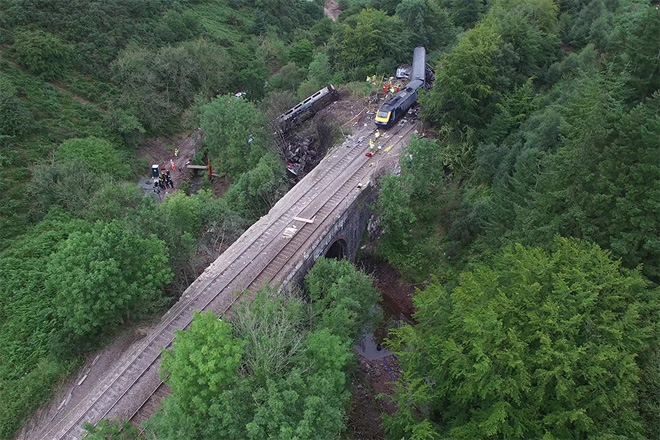An initial investigation into the fatal train derailment in Aberdeenshire has confirmed that the train struck a landslip, having turned back after its driver was warned of a separate landslip ahead.
The driver, conductor and a passenger were killed in the incident while another conductor (travelling as a passenger on this train) and five other passengers were taken to hospital
The Rail Accident Investigation Branch (RAIB) has published an initial account of the derailment, which occurred near Carmont in Scotland at around 09:40 on Wednesday.
All six vehicles of the train derailed after it struck a landslip around 1.4 miles (2.25 km) north-east of Carmont, Aberdeenshire. The train, which was operated by Abellio (trading as ScotRail), was a High Speed Train set with a leading power car, four passenger coaches and a rear power car and had started as the 06:38 from Aberdeen to Glasgow Queen Street.
After departing Stonehaven, the train continued past Carmont on the southbound line until it was stopped by the signaller at Carmont, using a radio message, because the signaller had just received a report from the driver of another train that a landslip was obstructing the southbound line between Carmont and Laurencekirk.

Aerial view of the site. Source: RAIB
‘When it became apparent that train 1T08 could not continue its journey south, the decision was taken to return it to Aberdeen, and it was routed back over a crossover at Carmont onto the down line. After travelling for approximately 1.4 miles (2.25 km), the train struck a landslip covering the down line and derailed.
‘As the track curved to the right, the train continued in a roughly straight line for around 100 yards (90 metres) until it struck a section of bridge parapet, which was destroyed. The leading power car continued over the bridge and then fell from the railway down a wooded embankment, as did the third passenger carriage.
‘The first passenger carriage came to rest on its roof, having rotated to be at right angles to the track. The second passenger carriage also overturned onto its roof and came to rest on the first carriage. The fourth passenger carriage remained upright and attached to the rear power car; it also came to rest on the first carriage. All wheelsets of the rear power car derailed, but it remained upright.’
The RAIB said it is collecting evidence to identify factors relevant to the cause of the derailment and its consequences. The scope of the investigation is likely to include:
- the sequence of events and the actions of those involved
- the operating procedures applied
- the management of earthworks and drainage in this area, including recent inspections and risk assessments
- the general management of earthworks and drainage and associated procedures designed to manage the risk of extreme weather events
- the behaviour of the train during, and following the derailment
- the consequences of the derailment and a review of the damage caused to the rolling stock
- underlying management factors
- actions taken in response to previous safety recommendations
It stressed that its investigation is independent of any investigation by the railway industry, and of the joint investigation instructed by the Lord Advocate to be carried out by British Transport Police, Police Scotland and the Office of Rail and Road.
Register now for full access
Register just once to get unrestricted, real-time coverage of the issues and challenges facing UK transport and highways engineers.
Full website content includes the latest news, exclusive commentary from leading industry figures and detailed topical analysis of the highways, transportation, environment and place-shaping sectors.
Use the link below to register your details for full, free access.
Already a registered? Login